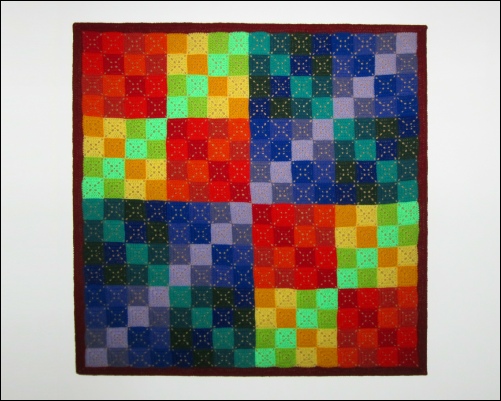




Son Ben has grown up listening to ‘I could knit that’ so it wasn’t surprising when
he had another ‘My Mum could knit that’ experience. He had been doing some complex
calculations as part of his job and it threw up a prettily coloured grid, which was
a ‘finite field’. All that was left was determining how best to represent the field
as an afghan/wall-
The afghan represents just a very small part of the complex maths that lies behind a finite field. The field is finite because there is a limit to the numbers it can use. For this afghan the counting numbers zero to fifteen were used. They were converted to binary, added together, in a special way, in every possible permutation, and then changed back to counting numbers. Because of the limit of the field the answer always lie in the range zero to fifteen.
Sixteen colours were then needed to represent those numbers. The colours make it very easy to see where patterns are repeated and how different blocks combine together to make new blocks. The colours were chosen so that they are close to the colours of the rainbow. Arranging them in this way makes it clear that they are all different. When similar colours are moved away from each other it isn’t always easy to tell which colour is which. It is difficult to get a range of 16 colours that blend together.
There are some very distinct diagonal lines in the colour arrangement so it seemed appropriate to use crochet squares that also had noticeable diagonals. When the light is behind the afghan, the holes in the squares add to the effect. Any type of knit or crochet could be used and some people have also used the design to make fabric patchwork quilts.
A finite field is also known as a Galois field. It is named after Évariste Galois, who was a French mathematician born in 1811. He died, in a duel, in 1832 but, in his short life, he laid down the basis of an area of maths that came to be known as abstract algebra and, in particular, group theory. It is not possible to know what uses he might have foreseen for his ideas but in recent years they have been invaluable in many branches of maths including cryptography, coding theory and quantum error correction. They are behind much of the security technology used in modern computers.
